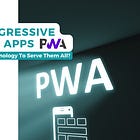A New Dawn For PWAs
Progressive Web Apps Are Even More Viable Now
Last Friday, I happily received a reader’s notification via email with the news that Apple had revoked the ban on PWA. That was a great message for me, because I am an entrepreneur who decided to go with Progressive Web Apps, or “Home Screen web apps”, how Apple is calling it loudly now.
Let me tell you why we face a new Dawn Of PWA, the year of #PWA2024.
The following quote shows Apple's statement and several aspects I want to write about in this newsletter.
It’s about continuing the current WebKit-Only implementation;
is that good or bad?Have we lost a battle here against Apple?
Many voices on Social Media say so. I think differently about that and will tell you why.
ℹ️ Here is the Update message announced by Apple:
Previously, Apple announced plans to remove the Home Screen web apps capability in the EU as part of our efforts to comply with the DMA. The need to remove the capability was informed by the complex security and privacy concerns associated with web apps to support alternative browser engines that would require building a new integration architecture that does not currently exist in iOS.
We have received requests to continue to offer support for Home Screen web apps in iOS, therefore we will continue to offer the existing Home Screen web apps capability in the EU. This support means Home Screen web apps continue to be built directly on WebKit and its security architecture, and align with the security and privacy model for native apps on iOS.
Developers and users who may have been impacted by the removal of Home Screen web apps in the beta release of iOS in the EU can expect the return of the existing functionality for Home Screen web apps with the availability of iOS 17.4 in early March.
https://developer.apple.com/support/dma-and-apps-in-the-eu/#dev-qa
🙏 Special thanks to everyone who fought the battle, especially the never-tiering Open Web Advocacy 1
Only WebKit Integrations For Now; Is That A Setback?
I read about voices on LinkedIn, which say that we went one step forward, two steps back, that we had lost the battle and failed to force a giant like Apple to fully comply with DMA2.
The reason behind that is the upcoming free choise of default Browser in EU version if iOS 17.4. However, as soon as we install a web app on the home screen (A2HS3), it only opens in the WebKit integration, or in simpler words, it will open in Safari, no matter what you do.
Voices claim that this doesn’t align with the rules of the EU’s DMA, since we shall have the freedom of choice, when it comes to browser.
At this point, I am not 100% sure about that. Yes, the browser is the foundation of a PWA, but when the app is installed on the device, we move into a hybrid state between the browser and the operating system. The application does have more capabilities and access.
This doesn’t mean I think Apple met the expectations, but as I stated in articles and videos beforehand, implementing a safe and secure architecture to integrate 3rd party browser provider into your ecosystem isn’t a cake-walk; even for Apple.
I think it will take time. Apple made possible that other browsers and alternative app stores are reality soon, things like Home Screen Web Apps (HSWA/PWA) will take some more time, due to the security reasons.
Side note on own security concerns - Malicious OpenWave browser spoofs Chrome browser
Last week, we got a ticket from a PWA user, who could not open the PWA anymore, since we had a browser white-list traditionally implemented for all browser which supported the features required.
The users stated, that he IS IN FACT using Google Chrome Mobile, and updated the browser; it must be a problem with the app.
👉 It wasn’t a Chrome Browser but looked exactly like it. ☣️
Important: The browser landscape is not regulated, and we are used to thinking about Google, Microsoft, Apple or Firefox, Opera and Brave; browsers of high credibility.
The problem with the DMA is it enforces freedom of choice, which is not only the subset of trustworthy browser we all know; it’s about all browser.
Do we really want to provide “browsers” like Wave-Browser deeper access to our devices? I do not, and I will not.
👉 But I am a tech professional and have a good chance to filter bad out. The common user can’t do that, which should be our quality and goal. This isn’t 100% given on iOS architecture yet.
Seriously, we don’t want to go back to times when Browser could access your local system freely and openly. I remember the early days of Internet Explorer, and I don’t miss it.
Live event: Start of a series to work on an upcoming PWA, live on stream. With Denis Čahuk from 🔮 Crafting Tech Teams.
Let’s give Apple more time to implement the EU’s DMA requirements correctly and accept that we can keep our PWAs for now.
I have all the companies and invidivuals in mind how already build up on the Progressive Web App foundation ❤️.
It’s about making the living for many people and of course many users rely on PWAs today already.
We cannot and should not endanger this foundation and existing ecosystem, because we want Apple to fullfill everything at once. Apple is late, and companies like Google and Microsoft are years ahead. Still, too much is already at stake – We need to proceed carefully and professionally.
So, I come to the second point of this newsletter.
Have We Lost The Battle Of Freedom Of Browser Choice Against Apple?
Yes, it was a battle, and yes, I believe PWAs or HSWAs don’t add to any revenue stream for Apple. And it seems that Apple has downplayed the usage of PWAs quite heavily.
Thanks to the work of many people on the web, especially the Open Web Advocacy, Apple got a lot strict pusback from the community. No one can ignore the fact that many of them are Apple users.
🍪 This leads to a point where Apple understands that there is an growing interest in the type of apps and that it might make sense to find ways to integrate the idea of PWAs more into it’s own ecosystem.
Progressive Web Apps got a lot of attention.
So many people claim, that Apple try to remove PWAs entirely from it’s ecosystem. As you can take from my articles and videos, I was skeptical about that. If there would not be DMA, we wouldn’t have had this discussion right now.
Further, just 2 weeks before the initial announcement of the iOS 17.4 PWA scandal, we praised the year of the PWA 2024. And one reason was that Apple / WebKit was pushing a lot of interesting features for web apps.
Affected were only iOS, not iPadOS or MacOS Systems, and only in the European Union. This was not an real attempt for me to remove PWAs from their ecosystem, since it only covered a fraction of their users.
I would even think in the direction of the following:
It is clear now that PWA is a public and business interest topic. It even bubbled up to the EU administration. This isn’t reversible anymore and simple cannot be ignored by Apple, or any other enterprise.
It is the year of PWA, 2024. A new dawn.
Most storms ending in rain, and after rain we have sunshine 🌤️. For me PWAs have clearly a future now, after this shocking, but maturing event.
Business people started to doubt the PWA idea.
Was it really a good choice?
What are we going to do now?
Will I lose everything?
How do we proceed in such a short amount of time?
☀️🍀 No, we will continue where we are right now, and from now on, everything will improve with more confidence. From this day on, it’s only a matter of time and I am 100% sure, Apple is preparing to integrate PWAs deeper into it’s ecosystem and eventually in the revenue system.
Do you agree with me, do you think different? Please let me know in the comments. Always appreciate your feedback.
Thanks for reading, and I hope you have a great Sunday!
Adrian,
FYI: Previously, the article in which I reacted to the worst-case scenario news:
FYI: About Progressive Web Apps
https://open-web-advocacy.org/
https://commission.europa.eu/strategy-and-policy/priorities-2019-2024/europe-fit-digital-age/digital-markets-act-ensuring-fair-and-open-digital-markets_en
https://udn.realityripple.com/docs/Web/Progressive_web_apps/Add_to_home_screen












Nice recap, Adrian! I believe the security concerns are quite valid for the regular, non technical people. I don’t see PWAs replacing the need for native apps but definitely some apps can be better implemented as PWAs. IMHO some additional verification/certification might be needed for extra confidence.